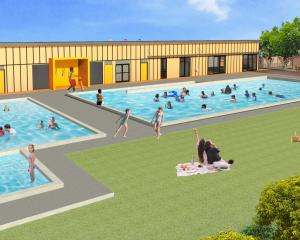
- First published by RNZ
- Follow Our Changing World on Apple Podcasts, Spotify, Stitcher, iHeartRADIO, Google Podcasts, RadioPublic or wherever you listen to your podcasts. Listen to this week’s episode to hear interviews with prize winner's Bianca Woyak, Carol Khor and Professor Dame Jane Harding.
Outdoor science for hands-on learning - Bianca Woyak - Science Teachers Prize
Bianca Woyak is passionate about what she does. "People call me high energy. I’ve got so much energy. I always give 150 per cent into anything that inspires me and I want to do."
Add a specialist science role, a supportive principal, large school grounds and an enthusiastic school full of students, and you’ve got a winning combination.
A teacher at Burnside Primary School in Ōtautahi Christchurch, Woyak has been awarded the 2021 Te Puiaki Kaiwhaaho Pūtaiao Science Teachers Prize for her success in engaging students in science through a range of environmentally focused activities.
These have included water testing in the local stream, riparian planting, beekeeping, growing trees for planting in Ōtautahi red zone areas and maintaining the school’s veggie patch and fruit trees.

This is how the B5 (Burnside Brings Back Boulder Butterfly) project came about. While studying the self-introduced Monarch butterfly the students started to wonder about local endemic species.
Working with local experts the team decided to recreate a boulder copper butterfly habitat on school grounds and translocated some of these as yet undescribed butterflies there.
When a new generation hatched, they knew that the project had been a success, and the students are now working with other schools and the local zoo to create boulder copper butterfly habitats there too.
Improving drug treatment for melanoma - Carol Khor - Future Scientist Prize
With our high UV exposure, Aotearoa leads the world in rates of skin cancer, and melanoma is the deadliest form.
This year’s Te Puiaki Kaipūtaiao Ānamata Future Scientist Prize winner, Carol Khor, a year 13 student at Burnside High School in Ōtautahi, is researching drug combinations that can better kill melanoma cancer cells.
Carol has been working alongside her mentor, PhD student Tess Featherston, at the Centre for Free Radical Research at the University of Otago, Christchurch.
In the lab, Carol has been growing up melanoma cancer cells and treating them with combinations of a known cancer specific drug plus an antioxidant drug.
Combining these two, she has shown, results in greater cancer cell death than with the cancer specific drug alone.Though the work is preliminary and has only been shown in the lab in cells, it could have implications for future melanoma treatments.
Carol and Tess are continuing their research this year and will write a paper on their findings for publication.
Carol has found the experience ‘thrilling’ and is excited about both the knowledge she has gained and the techniques she has learned.

About one in six babies are born at risk of low blood sugar, or hypoglycaemia. If the blood sugar levels remain too low for too long in babies it can lead to brain damage. But how long and how low may differ between individuals.
What then is the baseline level of blood sugars that should be acceptable for babies, and what is the best way to correct low blood sugars when they are detected?
The 2021 Te Pūiaki Pūtaiao Matua a Te Pirimia Science Prize winning team has spent more than 20 years researching this complex issue, with several longitudinal studies following babies from birth to childhood.
One of the major impacts of their work has been a detailed investigation into methods used to treat low blood sugars, and the rigorous testing of one of these – the rubbing of dextrose sugar gel inside the baby’s cheek.
Their research, led by Distinguished Professor Dame Jane Harding from the Liggins Institute at the University of Auckland, has led to changes in healthcare practice around the world, improving the lives of mothers and babies.

Dr Jemma Geoghan has been fascinated by the diversity of viruses and how they evolve and spread for quite a while. But, having moved to Ōtepoti in late 2019, the emergence of the SARS-CoV2 virus, and the resulting Covid-19 pandemic, launched her and her research into the spotlight across the last two years.
Geoghan is a Rutherford Discovery Fellow based at the University of Otago and an Associate Scientist at the Institute of Environmental Science and Research (ESR). Her research is focused on understanding the New Zealand virosphere – the collection of all viruses that can be found in Aotearoa - as well as how these viruses are related, how they evolve, and how they jump hosts.
Through her work with ESR, she played a key role in New Zealand’s Covid-19 response as a core part of the team responsible for genome sequencing of Covid-19 cases. This informed public health decisions, helped with better understanding of SARS-CoV2 transmission, and remains crucial for surveillance for the arrival of new variants of concern.
Geoghan’s fascinating research will be the focus of an upcoming Our Changing World episode, so keep an eye out for that.
Communicating Covid complexity – Toby Morris – Science Communication Prize
Cartoonist and illustrator Toby Morris has won the Te Puiaki Whakapā Pūtaiao Science Communication prize for his illustrations that conveyed complex information about the Covid-19 pandemic.
From the start of the pandemic, Morris collaborated with Dr Siouxsie Wiles to create illustrations about key scientific concepts.
The cartoon and animated graphics that came out of this collaboration were not only published on the Spinoff website, but also shared globally on social media, and were used by the Prime Minister to explain several key concepts during the New Zealand response.
- Listen to this episode about the 2020 winners
- In 2019 Dame Jane Harding was awarded the prestigious Rutherford Medal, she spoke to Alison Ballance about her research work.













